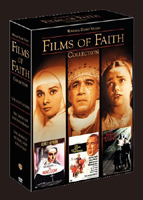 BUY IT AT AMAZON: CLICK HERE!
BUY IT AT AMAZON: CLICK HERE!
STUDIO: Warner Home Video
MSRP: $29.98
RATED: NR and G
RUNNING TIME: Nun: 152 mins/Shoes: 162 mins/Fatima: 102 mins
SPECIAL FEATURES:
• Shoes of the Fisherman vintage featurette
• Theatrical Trailers
 The Nun’s Story (1959)
The Nun’s Story (1959)
The Pitch
"I
say Audrey Hepburn in a nun’s habit is still more radiant than the sky during
the Battle of Los Angeles. As proof, I offer exhibit A, my film."
The Humans
Audrey
Hepburn, Peter Finch (Network)
The Nutshell
A brilliant
young nurse named Gabriella (Hepburn) chooses to devote her life to the church.
She has a heart to help the people of the
her a mission there. A trio of wills come into play — God’s, the church’s, and
Gabriella’s — all pulling in separate directions. Gabriella is forced to
examine what selflessness is capable within the structure of the church, and
how much is necessary to fulfill the missions of her heart.
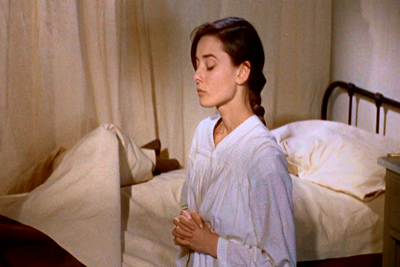
"Dear Lord, please send me a necromancer and an Arbuckle."
The Lowdown
Stories
with faith as their primary subject necessarily deal with a coming-of-age,
because what interests us about faith is its maintenance despite varied
challenges. Coming-of-age stories, however, rarely have clearly defined
conflicts, so they rely on character. The 400 Blows is a good example of
this kind of story, light on plot, but heavy on character. The Nun’s Story extends
the challenge a little further by placing its protagonist in a setting where
point number one is to eliminate as many traces of individuality as possible.
It wouldn’t do for a nun to have much of a distinct character, because that
creates room for pride, and pride is a violation of the Holy Rule. This is the
challenge that the filmmakers and Hepburn had to overcome.
In the
creation of a compelling setting and series of weighty moral and personal
decisions, they were absolutely successful. The core of the thematic conflict is
a little complicated, but is essentially this: Gabriella wants to help people,
and thinks to herself, how better to help people than to join with a religion
that promotes selflessness? Whereas the church thinks to itself, in order to be
truly selfless we must focus our attention on each individual’s relationship to
god. In fact, the church emphasizes a selfish and jealous relationship with god
over the selfless aid of fellow humans.
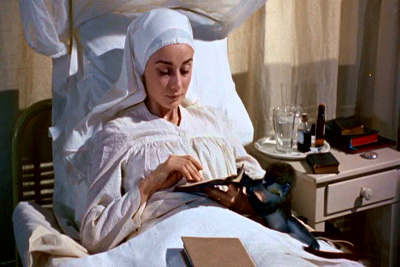
"No, no, Ms. Hepburn — first of all, you use too many adverbs.
Secondly, ‘pastrymurder’ should be hyphenated."
This
conflict is examined from a number of different angles, with characters popping
up from each vantage point to act as external conscience for Gabriella. Though
Hepburn was permitted very little room to express herself, she shines through
the few fissures in the cold exterior with a pureness of motive that becomes
the defining quality of her character, and which grows in slight increments as
the story progresses.
There is
no strict antagonist in The Nun’s Story, nor familiar arc of
conflict to define the film’s progression, so it does drag in places for those
who don’t want a doctrinal argument on disc. In my opinion, it’s a beautiful
film, with a fair-mindedness in emphasizing humanity — the only falsifiable
element in the question of faith — over religion and a lead performance that
portrays a wounded soul with delicacy and sympathy, and stops shy of letting it
be healed artificially.

 The Shoes of the Fisherman (1968)
The Shoes of the Fisherman (1968)
The Pitch
"It’s
Dr.
Strangelove with the pope!"
The Humans
Anthony Quinn, Vittorio de Sica, Sir Laurence Olivier,
Oskar Werner.
The
Nutshell
A former
archibishop and political prisoner of twenty years, Kiril Lakota (Quinn), is
released by the premier of the
great sacrifice for the faith, grants him a cardinalship as reward. Shortly
after, the pope dies and, as
conflict, Lakota is elected pope by the college of cardinals. Now he has to
discern between the wisdom of his old friends, his benefactors, and the god he
believes is aware of his every thought in an effort to halt the process of war.
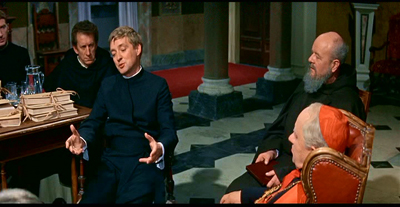
"Okay, I’ve got a good one. It’s midnight, moonless.
There are these two teenagers out at makeout point…"
The Lowdown
The Shoes of the
Fisherman has
the most epic scope of these three cosmically-minded films. Instead of being
irised in on a single nun, or a group of three children, it covers most of
war, and forms a second act out of the death of the pope and the ascendancy of
our protagonist to papal glory. It also features the largest cast of
recognizable names, and cinema legends, in this set.
Despite
the far-reaching effects of any of these plot elements, and the name-drops, the
story maintains the intimate, human emphasis necessary for any discussion of
faith. The disparate subjects of strict religion, evolutionary science, the
creation of evil, the survival of evil, political machination, paranoia, and
fidelity in marriage are combined and configured such that a unified picture is
created for the audience.
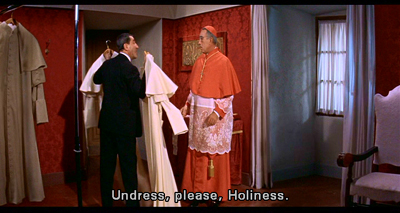
Straight to the top, I tell you!
That
picture is one that was timely in the late sixties, and remains so in the
current political climate. In the film, several nations are on a collision
course, with a terrible war as the point of impact. As the momentum builds,
Quinn’s character Pope Kiril I, is led to the idealistic conclusion that such
escalation can only be halted by deliberate sacrifice, and not in the
"Support Our Troops" sense of the word.
Thoughtful
though the film’s message may be, it would have more of an impact if the stakes
felt higher. We’re supposed to be observing a world in very real danger of
nuclear holocaust, and yet the grander conflicts are sidelined in favor of the
personal stories that lend a sympathy to the themes. It’s not a huge misstep,
and by no means should interfere with your involvement in the story, but it
does rob the conclusion of some of its emotional connection. In the end, The
Shoes of the Fisherman is a powerful drama that wastes not one moment’s
effort of its considerably talented cast and crew.

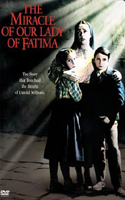 The Miracle of Our Lady of
The Miracle of Our Lady of
The Pitch
"Based
On A True Story — that always works."
The Humans
Susan
Whitney, Sherry Jackson, Sammy Ogg, Angela Clarke.
The Nutshell
In the
midst of a socialist revolution, the people of
religious freedoms, because of the Marxist stance on the practice of religion.
In the remote
have a vision of the virgin Mary, who tells them to return every month for
further revelations. It doesn’t take long for news of the vision to spread, and
soon the village streets are thronged with well-wishers, detractors, and
government agents eager to suppress the fanaticism. In the midst of such a
hubbub, can three uneducated children maintain their faith?

"Vote or die!"
The Lowdown
The Miracle of Our
Lady of Fatima
is sort of the odd-man out in this set. Instead of being an intimate character
study, it’s a melodrama; instead of being a careful weighing of the practicalities
and effects of faith, it’s a simple parable of the rewards given to the
faithful.
It’s
necessarily a melodrama, because the leads are children, and about as skilled
at conveying emotion and nuance as I am capable of writing a review without a
thesaurus at hand. They are put through a bit of a wringer, experiencing a
vision which they then have to defend against unbelievers amid questions of
their story’s veracity and their own sanity.
So it
doesn’t get into the meat of what internal struggles might accompany strange
visions of glowing women, but it does end up being a pretty good melodrama. It
is as political as the others in the set, in that it is concerned with the
interactions of characters, it’s just that the characters have no depth and
very little growth. The climate of revolutionary-era
government’s relationship to the people is far too simple. The government is
just a stumbling block in the way of people achieving their rightful levels of
faith, and the audience is meant to accept that that is the only obstacle worth
mentioning.
The Miracle of Our
Lady of Fatima
is neither as thoughtful or as skillfully-crafted as the other two films in
this set, but it is a charming tale about a situation that is as close to being
true as we can manage when dealing with religion.

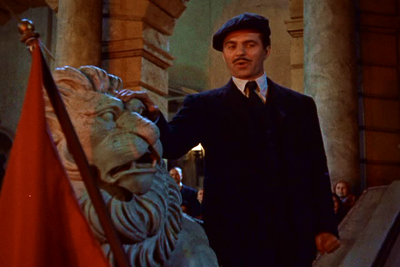
"This is my lion; with him I am well pleased."
The Packages
Each disc
is roughly comparable in terms of audio and video quality. All are restored
beautifully, though the soundtracks are of a relatively poor initial quality,
which is evident in the occasional distortion of high decibel stuff. The one exception is Shoes of the Fisherman which has a remastered Dolby 5.1 track, which does a great job with Alex North’s wonderful score.
There are few bonuses, save for trailers and a behind-the-scenes featurette from the initial release of Shoes of the Fisherman. The cover art for all three seem to be original poster material.
These
are discs you’d get for the content of the film, not for supporting information
or archival interest.
The Nun’s Story: 7.8 out of 10
The Shoes of the Fisherman: 8.2 out of 10
The Miracle of Our Lady of Fatima: 6.7 out of 10
Films of Faith:
7.5 out of 10